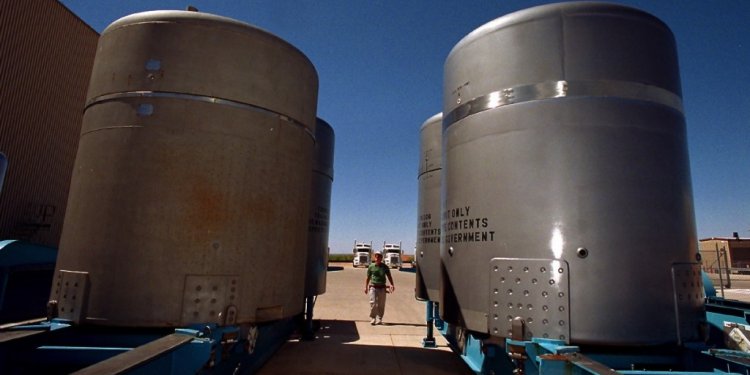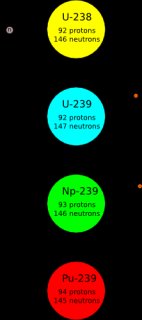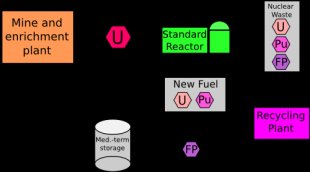
Nuclear Power Waste Disposal
 Nuclear waste is recyclable. Once reactor fuel (uranium or thorium) is used in a reactor, it can be treated and put into another reactor as fuel. In fact, typical reactors only extract a few percent of the energy in their fuel. You could power the entire US electricity grid off of the energy in nuclear waste for almost 100 years (details). If you recycle the waste, the final waste that is left over decays to harmlessness within a few hundred years, rather than a million years as with standard (unrecycled) nuclear waste. This page explains how this interesting process is possible.
Nuclear waste is recyclable. Once reactor fuel (uranium or thorium) is used in a reactor, it can be treated and put into another reactor as fuel. In fact, typical reactors only extract a few percent of the energy in their fuel. You could power the entire US electricity grid off of the energy in nuclear waste for almost 100 years (details). If you recycle the waste, the final waste that is left over decays to harmlessness within a few hundred years, rather than a million years as with standard (unrecycled) nuclear waste. This page explains how this interesting process is possible.
Nuclear Transformations
Before you go on, recall that Uranium exists in nature as 2 isotopes: the less common U-235, and the more common U-238. Conventional reactors mainly split U-235 to produce power, and the U-238 is often considered useless. When a standard reactor runs low on U-235, it must be refueled, even though there is a lot of U-238 still in there.
A common type of nuclear reaction is called beta-decay. When a nucleus has more neutrons than it would like to have, it often beta-decays by breaking a neutron into a proton and an electron. The electron (called a beta-particle in this case, since it originated in the nucleus) flies off into nature, and the main result seen in the nucleus is a neutron converting to a proton (see figure).
When U-238 absorbs a neutron in a nuclear reactor, it becomes U-239, which is just the isotope of Uranium with one extra neutron than U-238. This beta-decays quickly and becomes Np-239. Then, the Np-239 beta-decays again to become Pu-239, which is a fissile isotope that can power nuclear reactors.
The “useless” U-238 is the secret to recycling nuclear fuel. When it absorbs a single neutron, it goes through a series of nuclear reactions within a few days and turns into a very splittable isotope of Plutonium, Pu-239. The Pu-239 acts a lot like the U-235 that powers conventional reactors, so if you convert your U-238 to Pu-239 as you run your reactor, you can then use that Pu-239 to continue powering your reactor, or others!
Nuclear Fuel cycles
A nuclear fuel cycle is the path that nuclear fuel (Uranium, Thorium, Plutonium, etc.) takes as it is used to generate power in a nuclear reactor. Our fuel cycle page has more info. They describe where the material comes from and where it ends up. Different fuel cycles range from very simple to fairly complicated. We describe several of these below.
 Once Through Cycle
Once Through Cycle
Figure 1. A once-through fuel cycle. Put your mouse over each image for more info.
The simplest fuel cycle is the once-through cycle. It is the de-facto standard in most operating nuclear power plants, with a few exceptions in Europe and Asia. Uranium is mined, enriched, used in a reactor (where it becomes radioactive nuclear waste), and then stored until it is no longer dangerously radioactive. While this cycle is cheap, there are two major problems with it. Firstly, the waste is radioactive for hundreds of thousands of years. No one has been able to design a repository that is convincingly capable of storing material for that long. Secondly, Uranium is not the most abundant element on Earth, and in this kind of cycle, the global supply of cheap uranium could run low within 200 years. So much for sustainability! There are some deep-burn once-through cycles out there that have good sustainability properties though.
Closed Fuel Cycle
Figure 2. A closed fuel cycle. Here nuclear material is recycled. Put your mouse over each image for more info.
Closing the fuel cycle involves recycling the nuclear waste as new fuel. Since the main component of nuclear waste is Uranium-238 (which can be transmuted to Plutonium, especially with advanced breeder reactors), we can get more energy out of the waste than in a once-through cycle (see factoid 2 to see how much). The recycling plant separates the good stuff from the bad stuff. The bad stuff is mostly fission products, the atoms that a Uranium atom becomes after it splits in the fission process. These fission products mostly decay to safe levels within 300-500 years, which is significantly shorter than standard nuclear waste. So, by closing the fuel cycle with standard reactors, we address the issue of nuclear waste identified in the once-through cycle. In this case, nuclear waste is a tractable problem. But most of the reactivity is coming from the mine, since standard reactors burn most of the fissile nuclide, U-235. Also, the reprocessing technology is expensive and separates out pure Plutonium, which could possibly be stolen, bringing a rogue entity closer to having a nuclear weapon. For these reasons, the USA does not currently recycle. There are ways to solve these issues.
Breeder Fuel Cycle
Breeder reactors can create as much or more fissile material (atoms that readily split) than they use. These special reactors are designed to have extra neutrons flying around, so that some can convert U-238 to Pu-239 (see above) and the others can run the reactor. Often, these special reactors are deemed "fast" reactors because the neutrons are moving through the reactor at higher speeds, on average. In a full breeder fuel cycle, we get the maximum use of the Uranium resources on Earth, and what we already know exists can last tens of thousands of years. The cycle has cost and proliferation concerns associated with any closed cycle. Additionally, we have significantly less operational experience with breeder reactors, so we would need to train builders and operators for such a machine. Using a Thorium cycle instead of a Uranium-Plutonium cycle may allow breeding in less exotic reactors. Using this kind of fuel cycle, nuclear power can truly be considered sustainable.














